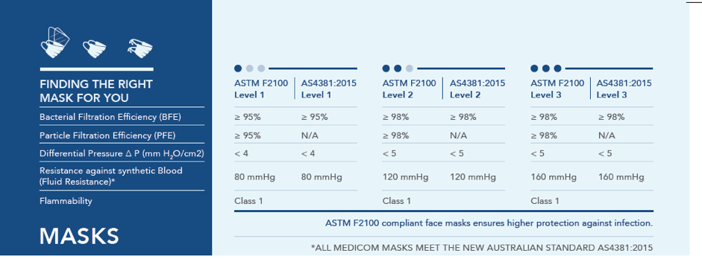In the current mask market, there are a variety of different options oral healthcare practitioners are able to choose from. These include options such as: basic surgical masks, anti-fog masks, fluid/splash resistant masks and face-shields. All these masks are made to cover the nose and mouth with a blend of certain characteristics; comfort, filtration and breathability. The combination of these three characteristics and the different design options creates a difficult decision for the oral healthcare professional when choosing the right mask. The purpose of this article is to discuss the different characteristics of face masks for healthcare environments with regard to the requirements of the Australian standards and ADA, to assist you in choosing the right mask for you and the practice.
Face Mask Standards
Who is responsible?
ASTM international (American Society of Testing and Materials) is the organisation responsible for the global implementation of face masks standards and levels. The organisation is responsible mainly for developing and publishing technical standards for materials, products, systems and services in healthcare. The Australian standards committee develops their standards in accordance with the global recommendation.
Australian standards
According to AS 4381:2015 (Single-use face masks for use in health care), a level 2 mask is a requirement for application of accreditation with the Australian Dental Association (ADA). Therefore, making a level 2 mask the recommended mask for the dental industry throughout Australia and New Zealand.
ASTM Face mask levels & what they mean
ASTM has characterised masks into different segments classified as levels. Below is a table in regards to the different levels and requirements for the levels of masks. In summary, a level 1 mask is a low barrier mask, to be used within environments with no risk of exposure to fluids. A level 2 mask is as discussed above, recommended for dental environments due to its higher resistance to penetration by synthetic blood (refer to table below). A level 3 mask is targeted towards medical environments where exposure to fluids and blood is extremely high, hence the resistance to penetration by synthetic blood mmHG level being 160 (in comparison with level 2 masks: 120mmHg).

Characteristics of masks
As discussed above, choosing the right mask may be a complicated task. However, it doesn’t have to be as complex as you may think if you consider the characteristics below and always remember masks should have a proper fit (contour the nose, chin and neck properly), be comfortable, have a fluid absorbency and be convenient. Please refer below to the characteristics in detail:
- Fit: The mask needs to be contoured to the individuals chin; nose and upper neck. The mask should not be gaping as this defeats the purpose of the mask if fitted poorly, and increases risk of infection due to exposure of the mouth and nose area (where micro-organisms are prone to entering).
- Convenience: Easy to put on and off. This will be a choice between ear loops and tie on.
- High ply: The thickness of the mask for the absorption of fluids.
- Bacterial filtration (BFE): Able to capture micro-organisms and prevent them from entering the mouth/nose area. > 98%
- Differential Pressure i.e Breathability: <5. The mask may have anti-fog properties, or consist of a breathable material. This will assist in any fogginess in eye wear.
- Flammability: Class 1
- Resistance against synthetic blood (fluid resistance): 120mmHg is the standard. Fluid resistance is essential as this prevents fluids being exposed to the mouth and nose area.
All these characteristics should be considered when purchasing face masks. Above all, comfort and protection should be the main factors in determining your preferred mask brand. If the mask is uncomfortable it is unlikely to be worn for the several minutes/hours it is needed to be, and therefore will risk cross contamination between the oral healthcare professionals and the patient.
Need more information on how to choose the right mask? Click here to view our detailed infograph!
Proud Leaders in Infection Control Since 1988
REFERENCES:
[1] CG Davies et al, Ann R Coll Surg Engl 2007 89(8): 770–772; S Endo et al, Jour Hospital Infection 2007 (67) 1: 56–61; DC Berridge et al, Br J Surg 1993 80 (11): 1379-80.
[1] Scott N & Jones H, ACA Research, Understanding the implications of changing face mask standards 2015.
[1] Morgan, David R. Mission the Point: A Review of Needlestick Injury and Occupational Risks From BloodBorne Viruses. Journal of American Biological Safety Association. 2001
.png)

